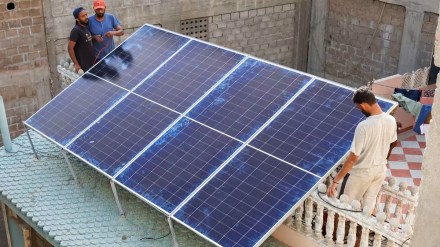The ministry of new and renewable energy has released operational guidelines for the implementation of the payment security mechanism and central financial assistance to residential consumers through renewable energy services company (RESCO) model and utility-led aggregation (ULA) model under the newly launched rooftop solar scheme – PM Surya Ghar Muft Bijli Yojana.
The implementation period of the scheme shall be till March 31, 2027, said the ministry.
As per the guidelines, to avail CFA, the residential rooftop solar plant would be the grid connected solar power system tagged to a particular residential power connection of the local DISCOM and will only include installations on a roof, terrace, balcony or on top of elevated structures.
Special rooftop solar installations such as Building Integrated PV (BiPV) systems shall also be considered eligible for CFA support. Additionally, installations under metering mechanisms such as group net metering and virtual net metering shall be eligible for CFA if the metering arrangement is approved by the DISCOM.
Central Financial Assistance for utility-led aggregation (ULA) proposals shall be released against those households for which the capacity installed is up to 3 KW, the guidelines said.
“The objective of the scheme component is to establish the implementation mechanism for supporting installations through RESCO and ULA models for rooftop solar for eligible consumer categories and to enable DISCOMs and state governments to support rooftop solar development under RESCO and ULA models of deployment,” it said.
Under the RESCO mode, the system is procured, installed, and maintained by a Renewable Energy Service Company for a period not less than 5 years which is also the project period. The consumer does not fund the initial investment into the rooftop solar system and is not the owner of the asset.
The consumer only pays for the electricity consumed from the rooftop solar system on a tariff basis to the RESCO operator. The plant ownership may be transferred to the consumer after the project period as per the terms and conditions agreed to between the consumer and the RESCO entity. Alternatively, the RESCO may enter into an arrangement with the DISCOM for sale of balance power, leftover post consumption by consumer to the grid under a power purchase agreement.
The utility-led asset model includes business models where the DISCOM or the state government or some other state designated entity install rooftop solar projects on behalf of individual residential sector households.
Furthermore, no financial assistance will be provided to non-residential segments of consumers including the government segment, and commercial & industrial segment among others.
“The rooftop solar installation may include additional technology components such as small wind hybrids, battery storage, solar tracker systems etc. However, the CFA calculation shall be based on the CFA structure under the scheme as per capacity of solar modules installed in the system,” the ministry said in its guidelines.
The guidelines also noted that solar modules used in the installation must satisfy the Domestic Content Requirement (DCR) condition i.e. domestically manufactured modules manufactured from domestically manufactured cells.
“This is an essential condition for the installation to be eligible for the CFA. Use of non-DCR modules in any form in the installation shall render the installation ineligible for CFA,” it said.
To avail the central financial assistance, RESCO will need to submit a declaration from the Original Equipment Manufacturer (OEM) certifying that the modules used in the installation meet DCR standards.
However, households with pre-existing rooftop solar shall not be considered eligible under RESCO and ULA models for CFA.
In addition to the above, the new and renewable energy ministry has announced a corpus of Rs 100 crore for a payment security mechanism that would be managed and administered by the national programme implementation agency in an interest-bearing bank account.
The proposals for the utility-led aggregation model can access the payment security mechanism (PSM) in order to provide payment security for projects in which RESCO partners have been contracted with, through an open transparent bidding process for tariff discovery.
“Under this arrangement, the ULA selected RESCO shall contribute to the PSM Corpus through a one-time PSM fee of Rs 2,000 per installation to be undertaken by it under the ULA,” the ministry said.
The government launched PM Surya Ghar: Muft Bijli Yojana back in February to increase the share of solar rooftop capacity and empower residential households to generate their own electricity. The scheme has an outlay of Rs 75,021 crore and is to be implemented till FY 2026-27.
The financial outlay for the scheme includes Central Financial Assistance to 1 crore residential consumers for installations of rooftop solar. In June 2024, the ministry had issued scheme guidelines for release of central financial assistance (CFA) to residential consumers for installations undertaken by them through registered vendors. However, earlier guidelines did not cover RESCO models or Utility Led/State Led Aggregation Models.
